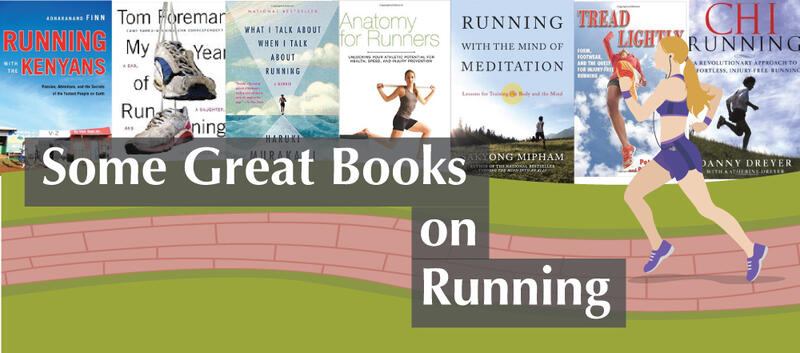
“In mind’s special processes, a ten-mile run takes far longer than the 60 minutes reported by a grandfather clock. Such time, in fact, hardly exists at all in the real world; it is all out on the trail somewhere, and you only go back to it when you are out there.” -Once a Runner
I’ve read quite a lot of books on running. As an obsessive autodidact, reading is a big part of how I learn. Not surprisingly, there are two parts to my journey to becoming a better running: running and reading.
I read a lot and I find long-form books to be one of the best ways to learn. This post is a followup on my previous post, “Some Great Books on Running,” where I reviewed nine other books on running.
In this post, we will look at several recent books I’ve read about running and endurance training. I will provide a short summary, review and rating of six more books.
Before jumping into my specific book reviews, I first wanted to share a few broad lessons I’ve acquired.
One Lesson: Train for Endurance, Speed and Target Pace
I’m not a professional runner or coach. I’d call myself a “competitive amateur runner,” since running for me is not simply about good health anymore; it’s about getting better. I’m also a tracker and documentary writer. I wrote about my first running steps in A Beginner’s Journey Training to Run 5K, and I recently chronicled my first marathon in Western China in post on ChengduLiving.com entitled “Don’t Turn Left at 24km.”
One of biggest overarching themes I’ve learned from reading (and watching videos and running myself) about running and endurance is that improvement is a slow process for any new runner. It takes years of training to develop the neurological and biomechanical capacities to become a better runner.
You need to improve your mobility, your strength and even your mind.
To avoid acute and chronic injuries, your training plan needs to be progressive, cycling through phases of progressive overload and recovery. You need challenges, assessments and occasional races to sharpen and push yourself.
You also need to eat right, sleep enough and manage your stress. If you aren’t getting the right balance of nutrition, sleep and stress, your training will suffer.
To train smart and to effectively improve, you need to do three things: build an endurance base, get faster, and target your goal pace.
The majority of research and writings about running point towards the fact that you have to slowly build up volume (run a lot of miles) and challenge yourself regularly to run faster (run for speed). These first two elements also need to be properly managed, distributed and targeted according to your recovery, adaption and goals. You might call this your training intensity distribution or “training polarization.”
These combined ends of the running training spectrum (endurance and speedwork) then should be applied toward the third key element of training and that’s training toward your specific endurance or event goal. You might call this third goal, race pace training. You need to learn to run at the target pace for the event.
The marathon and beyond adds an additional caveat to running training and that’s fueling. Anything shorter and you largely have enough stored fuel in your body to maintain yourself through upwards of 2 hours of an endurance workout or race. But beyond that your energy reserves get depleted and you need to make sure you provide enough nutrition to keep going. Otherwise you “hit the wall,” as runners like to say. As professional running coach put it, ultras (and marathons for that matter) are eating contests with some running in-between.
These are the lessons I’ve learned from reading over a dozen books on running, and they have started to provide the framework for which I train and consider new information around running too.
Six Categories for Books on Running
In “Some Great Books on Running,” I shared how I categorize books in the running and endurance sport. To summarize, I found that books on running can be divided into the following categories:
- “Getting Started” Books for Beginner Runners
- Running Training Plans & Methods (from 5k and 10k to Marathons and Ultras)
- Running Science, Techniques and Principles
- History of Running and Runners
- Body & Biomechanics of the Runner
- Memoirs on Running
In my previous post, “Some Great Books on Running,” I reviewed nine books on running, which fall into these categories:
- Running with the Kenyans: Passion, Adventure, and the Secrets of the Fastest People on Earth by Adharanand Finn
- Anatomy for Runners by Jay Dicqarry
- Ready to Run: Unlocking Your Potential to Run Naturally by Kelly Starrett,
- Runner’s World Run Less, Run Faster by Bill Pierce, Scott Murr, Ray Moss
- Tread Lightly by Peter Larson, Bill Katovsky
- ChiRunning: A Revolutionary Approach to Effortless, Injury-Free Running by Danny Dreyer, Katherine Dreyer
- My Year of Running Dangerously: A Dad, a Daughter, and a Ridiculous Plan by Tom Foreman
- Running with the Mind of Meditation: Lessons for Training Body and Mind by Sakyong Mipham
- What I Talk About When I Talk About Running by Haruki Murakami
Six categories isn’t many and frankly, many books on running fall into multiple categories. But it’s a good, general way of organizing books on running.
If I had to pick two books from that batch, I’d recommend the memoir, “What I Talk About When I Talk About Running,” which beautiful and well-written, and the science-focused book, “Tread Lightly,” which is detailed but not preachy about the latest science on running.
Let’s look at the latest books I’ve read about running and endurance.
Born to Run by Christopher McDougall
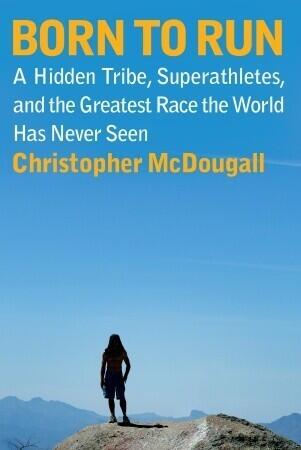
Mark’s Rating: 4 (out of 5). Published: 2009. Category: Memoirs on Running
Summary: “Born to Run: A Hidden Tribe, Superathletes, and the Greatest Race the World Has Never Seen” is a classic book on running. Following an injury, author and runner Christopher McDougall sets off a journey that leads him into Mexico’s deadly Copper Canyon to find the reclusive Tarahumara Indians. These superhuman runners can run through rough and hot terrain over vast distances and time. Filled with a motley crew of misfit runners like Caballo Blanco, a surfer, and a professional ultra marathon champion, this group of Americans traveled to the canyons for an epic 50-mile race with the Tarahumara on their home turf. Fun and enjoyable read for any runner.
Takeaway: This book attempts to make a strong argument that much of what we know about running is wrong, especially shoes. Specifically, the author purports to show the value of barefoot and minimalist shoes over traditional shoes. Moreover the author argues that much of history points to our origin as runners. To quote, “If you don’t think you were born to run you’re not only denying history. You’re denying who you are.” This too is an inspiring idea with some basis in fact, but impossible to know for certain. Ultimately, this book is more of a fantastic memoir of stories and ideas, rather than hard science. Read this book for inspiration, adventure and ideas to consider.
Fav Quote: “You don’t stop running because you get old, you get old because you stop running.”
Find “Born to Run” on Good Reads.
Shoe Dog: A Memoir by the Creator of Nike by Phil Knight
Mark’s Rating: 4 (out of 5). Published: 2016. Category: History of Running and Runners
Summary: “Shoe dogs were people who devoted themselves wholly to the making, selling, buying, or designing of shoes.” This book is a memoir about the creation of Nike and its footwear. Nike’s founder Phil Knight shares his entrepreneurial journey creating one of America’s most iconic brands. While not specifically about running, Nike’s rise ties closely into the transformation of professional track and field and recreational running too. Knight’s story touches on the importance of Japan’s footwear industry and Nike’s usage of factories and partnerships to build its iconic footwear. Similarly Nike became an important brand for athletes and stars from Prefontaine to many others. Knight was a driven entrepreneur who constantly balanced partners and opportunities all while pushing forward with grit and hustle. At the same time, he acknowledge both “luck” and good timing as important factors to his success.
Takeaway: Work hard, push forward but sometimes be aware when it is time to give up and look for the new opportunity. To quote, “And those who urge entrepreneurs to never give up? Charlatans. Sometimes you have to give up. Sometimes knowing when to give up, when to try something else, is genius. Giving up doesn’t mean stopping. Don’t ever stop.”
Fav Quote: “So why was selling shoes so different? Because, I realized, it wasn’t selling. I believed in running. I believed that if people got out and ran a few miles every day, the world would be a better place, and I believed these shoes were better to run in. People, sensing my belief, wanted some of that belief for themselves.”
Find “Shoe Dog” on Amazon.com.
Once a Runner by John L Parker
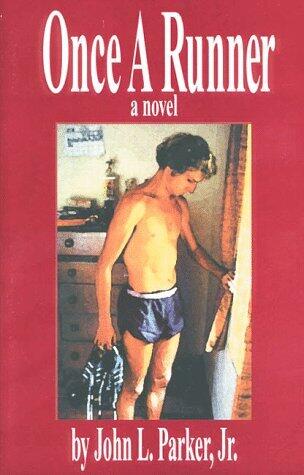
Mark’s Rating: 4 (out of 5). Published: 1978. Category: (Fictional) Memoir on Running
Summary: Originally self-published in 1978, Once a Runner is a novel about Quenton Cassidy, a fictional collegiate runner, and his maniacal devotion to competitive running. The tale follows the up’s and down’s while at training at his university. Initially somewhat tepid about running, Cassidy’s interest deepens under the tutelage of a fellow student, Bruce Denton. After a series of mishaps, he retreats from school and social life to dedicate himself to training. Beyond the storyline, the novel is embedded with a poetic passion for excellence, physical pursuits and devotion.
Takeaway: Great running is the mental consistency to go out and run better every time. To be a better runner you need to burn for it. This book is well-known in the running community and with good reason as it pulls at the heart strings about anyone pushing beyond themselves towards excellence and personal perfection. Similarly, to quote: “The key was not how fast he could run, but how fast he could run while tired.”
Fav Quote: “Cassidy very early on understood that a true runner ran even when he didn’t feel like it, and raced when he was supposed to, without excuses and with nothing held back. He ran to win, would die in the process if necessary, and was unimpressed by those who disavowed such a base motivation. You are not allowed to renounce that which you never possessed, he thought.”
Find “Once a Runner” on Amazon.com.
The Science of Running: How to find your limit and train to maximize your performance by Steve Magness
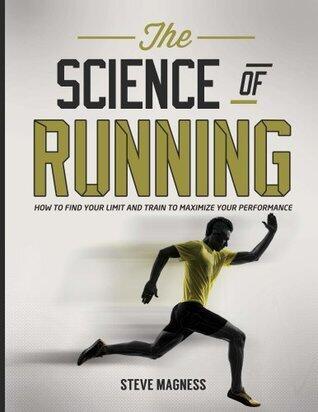
Mark’s Rating: 5 (out of 5). Published: 2014. Category: Running Science, Techniques and Principles
Summary: In the “The Science of Running: How to find your limit and train to maximize your performance,” Steve Magness goes deep into an analysis of running, technique and training. Long disparate viewpoints, he wedges his perspective between data-driven scientific researcher and hands-on, experienced coach. While this book falls squarely in the category of “Running Science, Techniques and Principles,” especially the first part, it is also contains a lot on training, which is covered in the second part. This book is not an easy read, nor a single answer to the science of running either. Magness attempts to create a systematic overview of the all the factors (known at present) that go into running and performance-focused training. Specifically, he looks at fatigue, the brain, oxygen, efficiency, brain-muscle connection, genetics, intensity, volume, and theories of training adaption like periodization.
Takeaway: This book came highly recommended to me. It definitely took focused time to read and digest, but it’s worth the effort since there is so much great info there. My main takeaway was around tailoring running training to specific goals. Magness summarize the list of manipulators in training as follows: 1) Speed, 2) Recovery, 3) Rep length, 4) Terrain, 5) Volume (total/sets), 6) Density, 7) “Stuff”, 8) Surges and 9) Feedback manipulators. For elite and specialist runners, you might consider using all of these, but for most runners, it’s about doing workouts that training for speed with intervals, repeats and sprints and for endurance with long slow runs. You can also add power with workouts on hills or soft surfaces. The “Stuff,” he mentions, relates to a surge or farlek over a long run. Magness goes into a lot of detail on training for an entire season whose ultimate aim is race specific training.
Fav Quote: “In general, most athletes can handle a week that includes 2 hard workouts and 2 medium workouts with the rest being a combination of distance runs and recovery runs.”
Find “The Science of Running” on Good Reads.
Beyond Training by Ben Greenfield
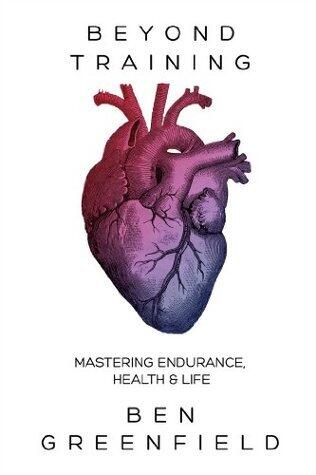
Mark’s Rating: 3 (out of 5). Published: 2014. Category: Running Science, Techniques and Principles
Summary: Unlike the other books in this list, Beyond Training by Ben Greenfield isn’t exclusively focused on running and run training. Greenfield is a triathlon athlete and his writings and podcast are all about personal optimization for health, fitness and more. To Quote: “This book is for every high achiever, exercise enthusiast, weekend warrior, gym junkie, biohacker, and health nut who wants to achieve amazing feats of physical, mental, and lifestyle performance without destroying their body, mind, and life.” Divided into five parts on Fitness, Recovery, Nutrition, Lifestyle and Brain, Greenfield provides a wealth of information and personal experiments with the objective “to leave behind the exhausting pursuit of exercise for the sake of exercise and discover the beautiful balance between health and performance.” If I would pick one topic over the others, I would say Greenfield’s best ideas are around prioritizing recovery and rest.
Takeaway: Greenfield’s book is a filled with a ton of research and various “hacks” to optimize our health and fitness, but the narrative lacks a comprehensive focus. Greenfield offers stark warnings about heart damage and overtraining found in many athletes, especially Ironmans. His approach, which he terms an “ancestral-athlete approach,” balances out building strength and mobility with high intensity sessions. To quote, “The key is to train in a manner that provides enough physical stimulus to increase fitness without overtraining or causing excessive oxidative stress.” Training shouldn’t make you a better athlete but hurt your health; it should make your stronger, faster and healthier too.
Fav Quote: “So make it your goal not simply to survive, but to thrive. And thriving means maintaining the ability to make babies, whether or not you actually do so.”
Find “Beyond Training: Mastering Endurance, Health Life” on Good Reads.
Sports Nutrition Guidebook by Nancy Clark
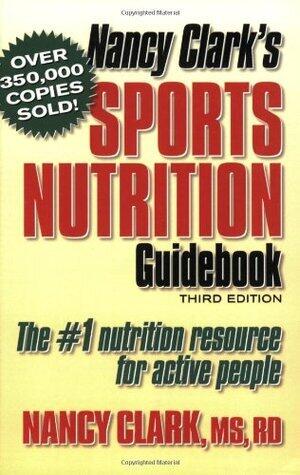
Mark’s Rating: 3 (out of 5). Originally Published: 1989. Category: Running Science, Techniques and Principles
Summary: This is a classic tome on sports nutrition science. Originally published in 1989 and revised 2003, this guide by Nancy Clark is somewhat generic on food and nutrition as a whole, but from the perspective of competitive athletes, it has quite a lot of tactical advice for fueling, training and competitions. As such, the two best sections to read are Chapter 9: Fueling Before Exercise and Chapter 10: Fueling During and After Exercise. Many of these ideas are still evolving the area of sports nutrition science, but this remains a good starting point with good rules of thumb.
Takeaway: Various research indicates that scentifific and individualized fueling plans can improve performance. Clark’s advice can be summarized in a few points: 1. “When engaging in extended periods of exercise, your goals are to maintain proper hydration and normal blood sugar levels.” 2. “While exercising, plan to eat carbohydrate-based foods (banana bread, energy bars, dried fruit, sports drinks, gels) every 60 to 90 minutes to maintain normal blood sugar levels. If you stop at lunchtime, eat a comfortable-sized meal, but in general try to distribute your calories evenly throughout the day.” 3. Your best bet is to mix up your foods and fluids so you get a variety of types of carbohydrate from commercial and natural foods. Instead of just sports drinks, choose a sports drink and dried apple rings or (part of) an energy bar plus extra water. Because different sugars use different transporters, you can absorb more carbohydrate and have more fuel to support your endurance exercise if you choose a variety of foods that offer a variety of forms of carbohydrate.”
Fav Quote: “No single medicine is as powerful as a healthy diet.”
Find “Sports Nutrition Guide by Nancy Clark” on GoodReads.com.
The Perfect Mile by Neal Bascomb
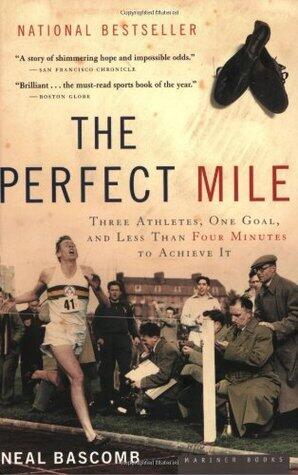
Mark’s Rating: 5 (out of 5). Published: 2004. Category: History of Running and Runners
Summary: In “The Perfect Mile: Three Athletes, One Goal, and Less Than Four Minutes to Achieve It,” we follow the quest to run a four-minute mile. As the author puts it, “this was the barrier, both physical and psychological, that begged to be broken. The number had a certain mathematical elegance.” Follow mutual disappointments at Helsinki Olympics in 1952, three amateur athletes on three continents (England, United States and Australia) pursue this long-thought impossible feat. Ultimately, part-time athlete, researcher and doctor, Roger Bannister becomes as the first person to run a mile under four minutes. Beyond the pursuit of winning, Bannister emerges as the epitome of a noble pursuit.
Takeaway: This book is a real inspiration. It got me thinking more about improving my speed at shorter distances through interval training. Whether your goal is long distance or short or just knowing more about the history of running, this is an excellent narrative.
Fav Quote: “Running the mile was an art form in itself. The distance — unlike the 100-yard sprint or the marathon — required a balance of speed and stamina. The person to break that barrier would have to be fast, diligently trained, and supremely aware of his body so that he would cross the finish line just at the pointof complete exhaustion…Winning a footrace, particularly one waged against the clock, was ultimately a battle with oneself, over oneself.”
Find “The Perfect Mile” on Amazon.com.
Conclusion: A Knowledgeable Beginner and His Running Tools
I’ll be the first to admit that books and online articles and videos have turned me into a rather dangerous combination: a knowledgeable beginner. That said, I think I’ve significantly nuanced my understanding about running and personal development through the combination of regular running, tracking and reading.
I’m not a scientist, but I believe that applying the broad concepts of research- and coach-backed training are actively improving my running ability and my understanding about running as a whole.
This recent batch of books on running contained several highly-recommended books about running, including some “Best of”s about running. If you are serious about running, curious about the science, or a data freak like me, I recommend you make the effort to read and study Steve Magnus’s “Science of Running.”
If you are looking for some inspiration, a good tale and a fast read, both “The Perfect Mile” and “Born to Run” were also excellent.
For now, as a runner, I feel good about my running training. Specifically, I’m honed in on training for speed and building up my endurance base. Both of these take awhile, but I’m seeing progress through consistency and aiming for, as the great Roger Bannister said, “quality workouts.”
Using some of the training principles from “Science of Running” about individualized training, I’ve started using an adaptive training tool called “TrainAsOne.” With TrainAsOne you set your specific goal and the system uses your tracked runs to provide a highly-targeted and individualized training program towards that goal.
Beyond running and reading, there is also a third variable that I’ve grown to respect and lend credence to, and that’s listening to your body. Listen to your body sounds a bit obvious at first glance nuanced, since it can be taken to notice aches and modify anything that doesn’t feel right. But this concept goes deeper.
Somewhere along the human journey we lost some of our corporal self-knowledge. We got distracted by societal demands and personal worries, and we stopped being able to realize that we are bodily beings too. I’m not saying that medical advice and expert running tips aren’t great. Instead, I’ve come to view much of what I hear and learn through the lenses of an embodied being. This physical embodiment of the runner is rarely discussed outright, but I notice that many of my favorite books on running are deeply connected to this theme of the runner as a transcendent physical being.
One of my favorite literary books is Don Delillo’s “The Body Artist,” which is a poetic meditation on a female character’s pursuit to incorporate an emotional history into herself through performance. It’s an amazing piece of writing and thinking since you realize how intertwined our existence is to this body.
While Ben Greenfield, Nancy Clark and Steve Magnus share much about the science of running and endurance, I feel like something is missing in their tales, and that’s the body as being-mover. In contrast, books like Born to Run, The Perfect Mile, and Once a Runner are at their best in this epically lived human-animal-runner. These books are reminders to me of this embodiment, and I find “listening to my body” to be a great joy on a long run through the great outdoors.
So, what’s my next read about running? Two classics in running training are Brad Hudson’s Run Faster and Jack Daniels’s Running Formula. Both of which I hope to one day read. I also enjoy history book, so I’m keen to read about Prefontaine and also “Running with the Buffaloes.” “Running and Being: The Total Experience” is also another classic to read too. Otherwise maybe it’s time to read less and run more!
What do you think about these books and running in general? What should I read or try next? Leave a comment or send me a message!
Happy running and happy reading about running!
